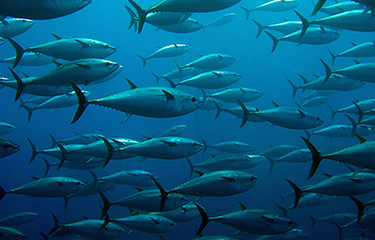Pacific island countries could lose an estimated USD 60 million (EUR 54.5 million) in revenue annually due to the impacts of climate change on the tuna population within the next 30 years, according to Conservation International (CI).
In a fact sheet produced by CI with the assistance of the Australian National Centre for Ocean Resources and Security (ANCORS), modeling indicates increases in ocean temperature due to climate change will cause skipjack and yellowfin tuna to shift to the east.
Johann Bell, senior director of the Pacific tuna fisheries at CI, told SeafoodSource that based on the modeling, by 2050, some of the fish will move to the high seas from the Pacific Exclusive Economic Zone (EEZ). That could affect revenue derived from licensing foreign fishing vessels, which fish in proximity to many small island nations.
“The general message was that by 2050 some of the fish will be moving out of the EEZs into the high seas areas, that is why there will be some loss in licensing revenues,” Bell said.
He added that currently, member countries of the Parties to the Nauru Agreement (PNA) can charge high prices under its vessel day scheme (VDS), so an assumption can be made that Pacific island governments will receive less revenue because foreign fishing fleets will be able to take catches from international waters without having to pay for fishing license fees.
In 2016, license fee revenue for all the Pacific Island Countries and Territories (PICT) was about USD 465 million (EUR 422.6 million)
The fact sheet produced by CI and ANCORS said the Western and Central Pacific Ocean (WCPO) supports the largest tuna fishery in the world, with an average annual tuna catch of 2.7 million tons in 2014-2018.
WCPO also provides for 56 percent of global tuna supply, and 2014-2018 data showed that 58 percent of the tuna catch from the WCPO is from the waters of Pacific Small Island Developing States (SIDS).
The WCP–CA purse-seine fishery is a skipjack fishery, with skipjack generally accounting for 76 percent of landings.
Based on the Western and Central Pacific Fisheries Commission documents, yellowfin accounted for 20 to 30 percent of the catch, with bigeye accounting for only a small proportion – 2 to 5 percent.
The documents further said that the combined Pacific-Islands fleet has been the "highest producer" in the tropical purse seine fishery since 2003.
The CI and ANCORS policy brief said that due to climate change, drops in revenues from tuna could mean an up to 15 percent drop in government revenue in many Pacific island countries.
Bell, however, said all of this is just a preliminary analysis. Over time they hope to get a better understanding of the modeling.
“But with the best available info we got, it's a cause for concern, that is why we are talking about this issue. We need to develop more confidence in this model before anything can be done to assist the Pacific island nations to retain the benefits the tuna they are currently receiving, we need better modeling,” he said.
In the policy brief, it made recommendations on how to reduce uncertainty and enable PICTs to get ready to address climate-driven losses in government revenue by identifying the structure of Pacific tuna stocks; model the response of each stock under both high- and low-GHG emissions scenarios; and compile integrated maps of the expected redistribution of each tuna species within its range under different GHG emissions scenario.
“These investments will enable PICTs to identify future changes in tuna revenue with greater certainty, and to negotiate arrangements to retain the present benefits they receive from tuna,” Bell said.
Bell stressed that while the information suggests a potential future that’s cause for concern, more information is needed.







